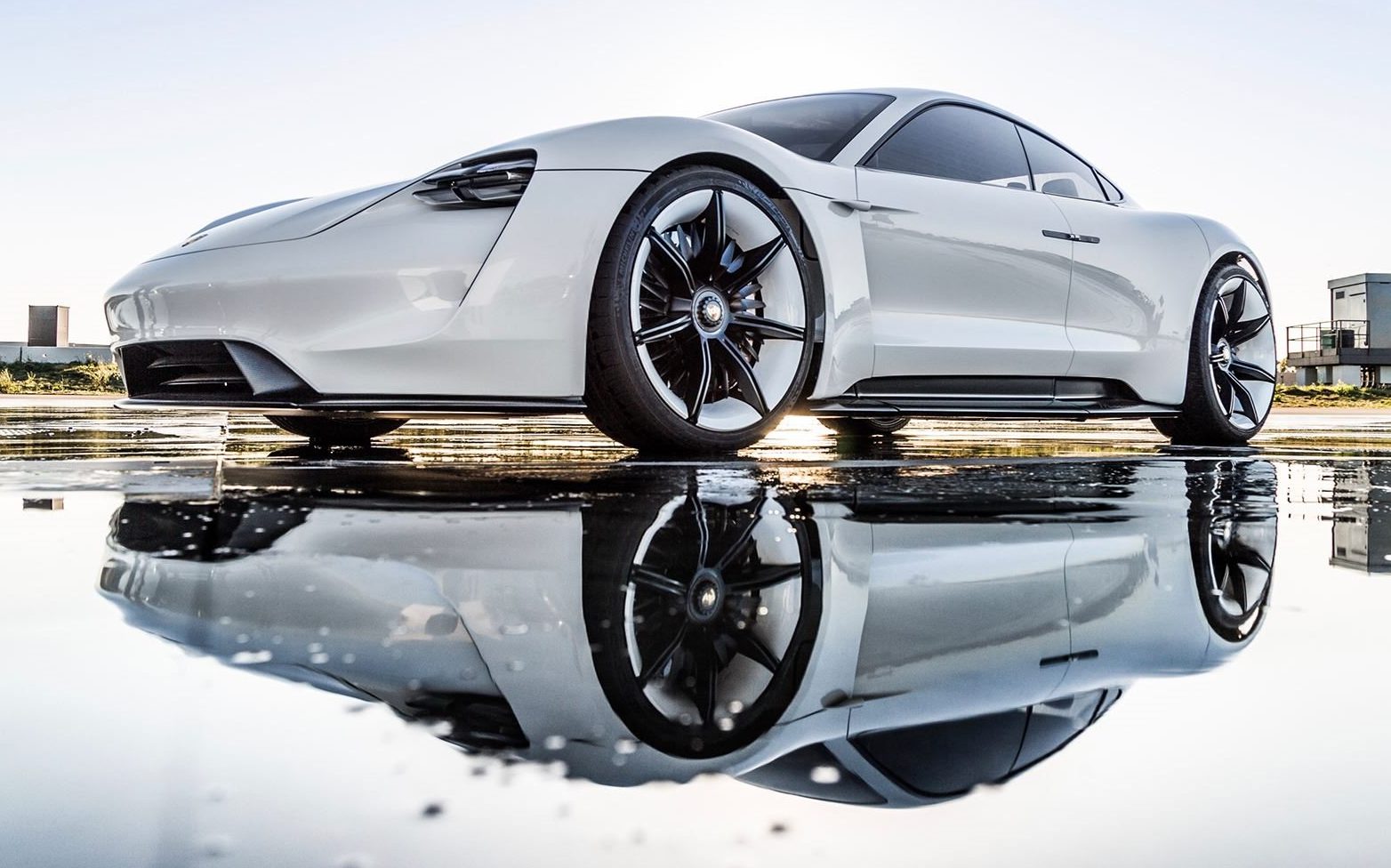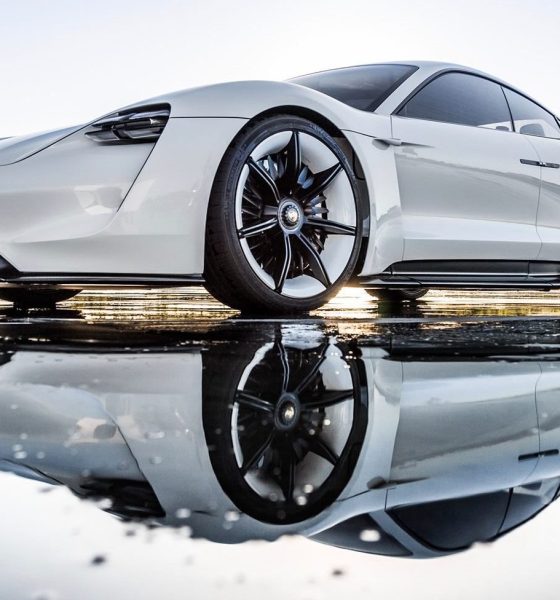

News
Porsche begins to market the Taycan in dealerships through customer deposit program
The Porsche Taycan is expected to be released sometime next year, but the German legacy automaker is already starting its marketing efforts for the all-electric car. The stakes are high for the carmaker — if it can design the Taycan in such a way that it rivals the best electric vehicles on the market like the Tesla Model S, the company can establish itself as a leader in the emerging EV market. If the car comes up short of expectations, the Taycan will end up being delegated as a footnote in the list of electric cars that never reached their potential.
Porsche started accepting pre-orders for the vehicle earlier this year, though the company initially extended the offer to several selected countries such as Norway, partly due to the country’s open support for electric mobility. The pre-orders for the vehicle were extended to the United States recently as well, by means of a Deposit Option Program for customers residing in the country. Interested buyers can fill up an online form to be part of the program, after which they will be sent information and updates about the electric car from a selected Porsche dealer. An example of a pre-order form for US-based Porsche Taycan customers can be accessed here.
Porsche is yet to reveal the final production version of the Taycan. The legacy carmaker still uses the Mission E sedan concept in its promotional materials for the upcoming electric car. A number of camouflaged test mules have been made, but the test vehicles are disguised with elements that will surely not make it to the production model, such as twin exhaust pipes at the rear. Despite not revealing the car’s final production model, Porsche Managing Director Alexander Pollich announced last month that the company is seeing a strong, positive reception to the vehicle so far.
Among the legacy automakers that are currently developing an all-electric car, Porsche appears to be one of the most serious about its desire to transition into the electric mobility age. As details of the Taycan trickled out over the years, it became quite evident that the all-electric, four-door sedan would be a serious competitor to the mainstays of the EV industry like the Model S. Porsche even notes that the Taycan will have the same soul and pedigree found in its iconic gas-powered vehicles such as the Porsche 911. Former race car driver Mark Webber echoed this sentiment during a test drive of the car, stating that the Taycan handles and feels very much “like a Porsche.”
Back in 2014, Elon Musk stated that the hoped Tesla “could address the false perception that people have that an electric car had to be ugly and slow and boring like a golf cart.” Just a year after that, Porsche debuted the Mission E sedan concept car at the 2015 Frankfurt Motor Show, and it has become a poster child for Porsche’s transition to electric mobility ever since. Porsche even expanded the Mission E line earlier this year, revealing a more rugged, off-road version of the vehicle dubbed as the Mission E Cross Turismo. The company also stated that by 2025, it aims for “every second Porsche sold to have an electric drive unit,” meaning half of its offerings would be fully electric while the other half will be plug-in hybrids.
The Porsche Taycan is expected to feature the legacy carmaker’s trademark performance, with the vehicle listed with a 0-60 mph time of 3.5 seconds, a range of 310 miles per charge, and a top speed of 155 mph. The electric car is expected to be produced at a facility located at Zuffenhausen, a suburb in Stuttgart, Germany — the same factory where Porsche manufactures some of its finest vehicles like the 911, 718 Boxster, and the 718 Cayman. Porsche is expecting to manufacture 20,000 Taycans per year when it begins production.

News
Tesla FSD fleet is nearing 7 billion total miles, including 2.5 billion city miles
As can be seen on Tesla’s official FSD webpage, vehicles equipped with the system have now navigated over 6.99 billion miles.

Tesla’s Full Self-Driving (Supervised) fleet is closing in on almost 7 billion total miles driven, as per data posted by the company on its official FSD webpage.
These figures hint at the massive scale of data fueling Tesla’s rapid FSD improvements, which have been quite notable as of late.
FSD mileage milestones
As can be seen on Tesla’s official FSD webpage, vehicles equipped with the system have now navigated over 6.99 billion miles. Tesla owner and avid FSD tester Whole Mars Catalog also shared a screenshot indicating that from the nearly 7 billion miles traveled by the FSD fleet, more than 2.5 billion miles were driven inside cities.
City miles are particularly valuable for complex urban scenarios like unprotected turns, pedestrian interactions, and traffic lights. This is also the difference-maker for FSD, as only complex solutions, such as Waymo’s self-driving taxis, operate similarly on inner-city streets. And even then, incidents such as the San Francisco blackouts have proven challenging for sensor-rich vehicles like Waymos.
Tesla’s data edge
Tesla has a number of advantages in the autonomous vehicle sector, one of which is the size of its fleet and the number of vehicles training FSD on real-world roads. Tesla’s nearly 7 billion FSD miles then allow the company to roll out updates that make its vehicles behave like they are being driven by experienced drivers, even if they are operating on their own.
So notable are Tesla’s improvements to FSD that NVIDIA Director of Robotics Jim Fan, after experiencing FSD v14, noted that the system is the first AI that passes what he described as a “Physical Turing Test.”
“Despite knowing exactly how robot learning works, I still find it magical watching the steering wheel turn by itself. First it feels surreal, next it becomes routine. Then, like the smartphone, taking it away actively hurts. This is how humanity gets rewired and glued to god-like technologies,” Fan wrote in a post on X.
News
Tesla starts showing how FSD will change lives in Europe
Local officials tested the system on narrow country roads and were impressed by FSD’s smooth, human-like driving, with some calling the service a game-changer for everyday life in areas that are far from urban centers.

Tesla has launched Europe’s first public shuttle service using Full Self-Driving (Supervised) in the rural Eifelkreis Bitburg-Prüm region of Germany, demonstrating how the technology can restore independence and mobility for people who struggle with limited transport options.
Local officials tested the system on narrow country roads and were impressed by FSD’s smooth, human-like driving, with some calling the service a game-changer for everyday life in areas that are far from urban centers.
Officials see real impact on rural residents
Arzfeld Mayor Johannes Kuhl and District Administrator Andreas Kruppert personally tested the Tesla shuttle service. This allowed them to see just how well FSD navigated winding lanes and rural roads confidently. Kruppert said, “Autonomous driving sounds like science fiction to many, but we simply see here that it works totally well in rural regions too.” Kuhl, for his part, also noted that FSD “feels like a very experienced driver.”
The pilot complements the area’s “Citizen Bus” program, which provides on-demand rides for elderly residents who can no longer drive themselves. Tesla Europe shared a video of a demonstration of the service, highlighting how FSD gives people their freedom back, even in places where public transport is not as prevalent.
What the Ministry for Economic Affairs and Transport says
Rhineland-Palatinate’s Minister Daniela Schmitt supported the project, praising the collaboration that made this “first of its kind in Europe” possible. As per the ministry, the rural rollout for the service shows FSD’s potential beyond major cities, and it delivers tangible benefits like grocery runs, doctor visits, and social connections for isolated residents.
“Reliable and flexible mobility is especially vital in rural areas. With the launch of a shuttle service using self-driving vehicles (FSD supervised) by Tesla in the Eifelkreis Bitburg-Prüm, an innovative pilot project is now getting underway that complements local community bus services. It is the first project of its kind in Europe.
“The result is a real gain for rural mobility: greater accessibility, more flexibility and tangible benefits for everyday life. A strong signal for innovation, cooperation and future-oriented mobility beyond urban centers,” the ministry wrote in a LinkedIn post.
News
Tesla China quietly posts Robotaxi-related job listing
Tesla China is currently seeking a Low Voltage Electrical Engineer to work on circuit board design for the company’s autonomous vehicles.

Tesla has posted a new job listing in Shanghai explicitly tied to its Robotaxi program, fueling speculation that the company is preparing to launch its dedicated autonomous ride-hailing service in China.
As noted in the listing, Tesla China is currently seeking a Low Voltage Electrical Engineer to work on circuit board design for the company’s autonomous vehicles.
Robotaxi-specific role
The listing, which was shared on social media platform X by industry watcher @tslaming, suggested that Tesla China is looking to fill the role urgently. The job listing itself specifically mentions that the person hired for the role will be working on the Low Voltage Hardware team, which would design the circuit boards that would serve as the nervous system of the Robotaxi.
Key tasks for the role, as indicated in the job listing, include collaboration with PCB layout, firmware, mechanical, program management, and validation teams, among other responsibilities. The role is based in Shanghai.
China Robotaxi launch
China represents a massive potential market for robotaxis, with its dense urban centers and supportive policies in select cities. Tesla has limited permission to roll out FSD in the country, though despite this, its vehicles have been hailed as among the best in the market when it comes to autonomous features. So far, at least, it appears that China supports Tesla’s FSD and Robotaxi rollout.
This was hinted at in November, when Tesla brought the Cybercab to the 8th China International Import Expo (CIIE) in Shanghai, marking the first time that the autonomous two-seater was brought to the Asia-Pacific region. The vehicle, despite not having a release date in China, received a significant amount of interest among the event’s attendees.








